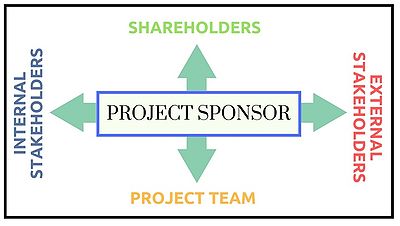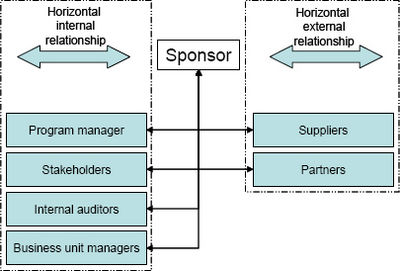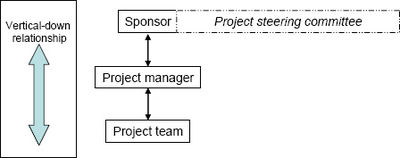The Role of the Project Sponsor
(→Abstract) |
(→Introduction) |
||
| Line 4: | Line 4: | ||
=='''Introduction'''== | =='''Introduction'''== | ||
| + | |||
| + | The term “Project Sponsor” appears to have emerged at the end of the 1980s. In 1990, the term appears in the book “Project Leadership by Brines Geddes and Hastings, 1990”, defining the project sponsor as the “Project Manager boss”. In 1993, J. Rodney Turner (Handbook of Project-based Management: Leading Strategic Change in Organizations) discussed the sponsor as the “owner” of the project, the person who paid for the work and controlled the flow of the money. | ||
| + | Regardless of the precise definition of the role, the term “project sponsor” has come into widespread use in the context of internal projects. | ||
=='''The Project Sponsor'''== | =='''The Project Sponsor'''== | ||
Revision as of 20:29, 18 February 2018
Contents |
Abstract
A sponsor is the person or group who provides resources and support for the project, and is accountable for enabling success. The sponsor may be external or internal to the project manager's organization [1]. This is a critical role, as is focused on monitoring and controlling the project in a strategic level. It Is very common to associate the term “Project Sponsor” to a disconnect stakeholder from the project. On the contrary, a Project Sponsor can define the difference among success and failure. Moreover, one of the fundamentals reasons why a project fails is the absence of executive sponsorship and management [2]. The Sponsor owns the business case and leads the project through the initiating processes until formally authorized, and plays a significant role in the development of the initial scope and charter [3]. Therefore, it is vital to establish a close relationship between the sponsor and the P3(Glossary) to ensure that the business case remains viable and it will deliver the stipulated goal and benefits. There is a lack of understanding of the impact that a Project Sponsor can address on the success of a project. The main goal of this article is defining the role and responsibility and identify the importance of a Project Sponsor in any project.
Introduction
The term “Project Sponsor” appears to have emerged at the end of the 1980s. In 1990, the term appears in the book “Project Leadership by Brines Geddes and Hastings, 1990”, defining the project sponsor as the “Project Manager boss”. In 1993, J. Rodney Turner (Handbook of Project-based Management: Leading Strategic Change in Organizations) discussed the sponsor as the “owner” of the project, the person who paid for the work and controlled the flow of the money. Regardless of the precise definition of the role, the term “project sponsor” has come into widespread use in the context of internal projects.
The Project Sponsor
Definition and Responsibilities
According to the PMBOK® Guide, a sponsor is the person or group that provides the financial resources, in cash or kind, for the project. When a project is first conceived, the sponsor champions the project. This includes serving as spokesperson to higher level of management to gather support throughout the organization and promote the benefits that the project will bring. The sponsor leads the project through the engagement or selection process until formally authorized, and plays a significant role in the development of the initial scope and charter. For matters that are beyond the control of the project manager, the sponsor serves as an escalation path. The sponsor may also be involved in other important issues such as authorizing changes in scope, phase-end reviews, and go/no-go decisions when risks are particularly high. ref3
In dissecting this definition we can extract the following responsibilities of a sponsor: [4]
- Champion the project
- Lead the project through the engagement or selection process until formally authorized
- Provide a significant role in the development of the initial scope and charter
- Serve as an escalation path
- Authorize changes in scope
- Provide go/no-go decisions.
General Role
The sponsor leads the project through the initiating processes until formally authorized, and plays a significant role in the development of the initial scope and charter. For issues that are beyond the control of the project manager, the sponsor serves as an escalation path [1]. The Project Sponsor Role is responsible for providing good governance for the project. This includes the following: [5]:
- Maintaining a focus on the broader issues on behalf of the project / informing the project manager and team of organizational and environmental changes which might impact the project.
- Establishing connections on behalf of the project, and supporting interfaces between the project team and the winder organization and external environment.
- Advocating on behalf of the project with the senior executive and other key senior stakeholders.
- Clearing pathways so that key resources can be obtained for the project.
- Motivating the project team when times are difficult.
- Objectively criticizing project performance.
- Providing ad hoc support to the project manager and the project team, including mentoring.
- Approving finance.
Role between the Project and the Organisation
The Project Sponsor often serves as the liaison between the project and the organisation. The sponsor has different responsibilities towards different stakeholders during different phases of the project life-cycle. These responsibilities are what ultimately determine the attributes required by the individual who will act in this role.[6] Figure 1 illustrated the framework (Lechtman, 2005[7]) for describing and analyzing the pivotal role with 360 degree relationships. It is clear that there are four main sets of relationships, namely vertical-up, horizontal internal, horizontal external and vertical-down.
- Vertical-Up Relationship: this section relates to the senior managers, directors and executives. Aligning the project with strategic objectives, ensuring good governance and managing the relationship with senior management (Figure 2). The sponsor is mainly responsible for re-defining the existing way of doing business through innovation and new ideas and is, therefore, the idea originator. This is followed by selling the idea or project to the decision-making body and obtaining the necessary funding for it.(ref6). The project sponsor should understand the greater impact the project will have on the organization now and in the future. Ensuring that governance is maintained on the project through representing the project in governance structures within the organization. This means taking full accountability, responsibility and ownership of the project, ensuring that it is correctly resourced with the right people, that it is funded properly and enjoys the correct priorities. Moreover, this role is expected to solve any senior management conflict that could compromise the evolution of the project.
- The Horizontal Relationship: As shown in Figure 3, relates to the different internal stakeholders and business unit managers as well as external relationships with vendors, suppliers and partners. From the internal relationship viewpoint, there is an expectation that the sponsor should understand what is expected from the project from a business perspective. The sponsor must ensure buy-in and cooperation from peers and all other stakeholders. Maintaining a good relationship with peers and stakeholders will assist with removing any obstacles that requires hierarchical power. The external relationship viewpoint, the sponsor should liaise with and acquire support from all third party suppliers and vendors and ensure that all deliverable are appropriate. The sponsor should also ensure that the requirements of external partners, such as a holding company, are addressed through the project. The above can be summarized into two main responsibilities namely to build and maintain relationship with internal and external stakeholders, to facilitate an environment and political climate that is conducive to project success.(ref6)
- The vertical-down relationship: The expectation from the project manager and team is that the sponsor should drive the implementation of the project and facilitate changes to the environment through supporting the change processes. The person in this role should provide leadership in the project and the business and make decisions on what is in the best interests of the organization. The sponsor should work very closely with and give direction to the project manager and team (Figure 4) and ensure the project remains on track by maintaining discipline. From the project team point of view, the sponsor must assemble an efficient team and be involved in the guidance, support and motivation of the team. Regular communication with the team should also take place to obtain their feedback. There are also task-related expectations of the sponsor that include prioritizing project requirements and the timely approval of changes according to the change management process. The sponsor must make decisions where they cannot be made by the team or project manager, and escalate problems that must be resolved.(ref6)
Project Stakeholders & Governance
Project Stakeholders
Project Sponsor vs: Project Management & Project Owner
Conclusion
Glossary
P3: Project, Program and Portfolio Management. [8]
Bibliography
References- ↑ 1.0 1.1 A Guide to the Project Management Body of Knowledge PMBOK® Guide, Fifth Edition, 2.2 Project Stakeholders and Governance
- ↑ KPMG New Zealand Project Management Survey 2010
- ↑ A Guide to the Project Management Body of Knowledge PMBOK® Guide, Fifth Edition, 2.2.1 Project Stakeholders
- ↑ https://www.pmi.org/learning/library/project-sponsorship-collaborative-journey-6210. James, V. M. (2011). Project sponsorship: a collaborative journey. Paper presented at PMI® Global Congress 2011—North America, Dallas, TX. Newtown Square, PA: Project Management Institute
- ↑ Tools for Complex Projects, CRC Press, 2016. Kaye Remington, Julien Pollack. Role definition, page 125
- ↑ https://www.pmi.org/learning/library/exploring-role-executive-project-sponsor-8107. Labuschagne, L., Cooke-Davies, T., Crawford, L., Hobbs, J. B., & Remington, K. (2006). Exploring the role of the project sponsor. Paper presented at PMI® Global Congress 2006—North America, Seattle, WA. Newtown Square, PA: Project Management Institute.
- ↑ Lechtman, E. (2005). A Holistic Framework for Successfully Sponsoring ITProjects
- ↑ https://www.apm.org.uk/body-of-knowledge/p3-management/. Association for Project Management




